He stands over 6 feet tall and is tatted from head to toe. Upon first glance, Lil Peep (whose birth name is Gustav Ahr) looks like the archetype white, SoundCloud rapper trying to make it from the underground to the industry. Although that narrative isn’t completely false, Lil Peep differs from most mainstream SoundCloud rappers as an openly bisexual male. While many rappers try to push forward an image of toxic hypermasculinity (which gives rap and hip-hop a bad name), Lil Peep embraces his sexuality and expresses himself through fashion, which is oftentimes androgynous or “feminine.” He even had the chance to sit front row at Paris fashion week for the Balmain Runway and has appeared in magazines like GQ and Vogue.
His Debut Album “Come Over When You’re Sober, Part 1” was released on August 15, 2017, and has already been skyrocketing, with his music video for the song “Awful Things” featuring Lil Tracy garnering over 6 million views on YouTube. On top of that, Lil Peep is galvanizing the post-emo revival, with many of his songs incorporating and sampling songs by artists in the “emo/rock” genre. He’s definitely one of the first few Emo Trap artists we’ve seen get recognition along with the likes of Lil Uzi Vert and XXXTentacion (who I refuse to support because he is abusive).
Besides being openly bisexual (for which he has received a lot of hate for), taking part in the post-emo revival and being a fashion icon, Lil Peep also discusses mental illness in interviews and in his songs. He grew up in Ronkonkoma, a town in the Long Island suburbs of New York, and says he dealt with and continues to deal with anxiety, often never leaving his house for long periods of time. Like many other artists, he uses music to give a voice to his conflicting feelings and his anxiety.
Upon first glance, Lil Peep may not look like anything we haven’t seen before from the hip-hop community. But once you listen to his music, which doesn’t necessarily all center around rap, but rather ventures into punk and pop, we begin to see a new diversity in sound in hip-hop. We also see a representation of an LGBTQ man in an industry that has produced very few LGBTQ icons and is still criticized as being homophobic. There is still a lot of work left to do to destigmatize being queer and mental illnesses, but Lil Peep is catalyzing a lot of change with his platform.
Here’s a link to his new album on SoundCloud if you want to listen to some bops.












